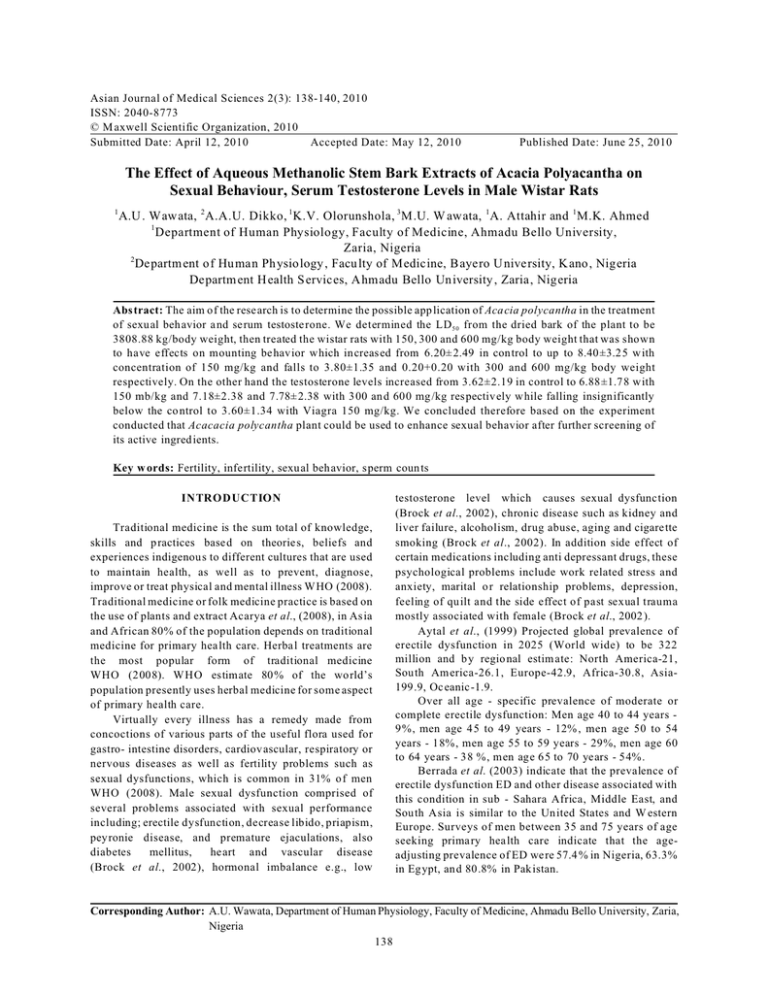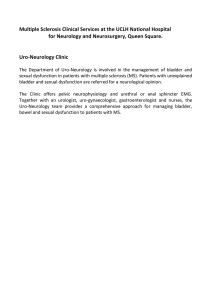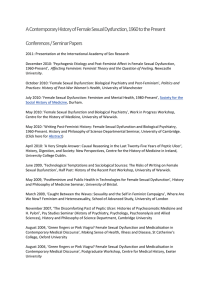
Asian Journal of Medical Sciences 2(3): 138-140, 2010
ISSN: 2040-8773
© M axwell Scientific Organization, 2010
Submitted Date: April 12, 2010
Accepted Date: May 12, 2010
Published Date: June 25, 2010
The Effect of Aqueous Methanolic Stem Bark Extracts of Acacia Polyacantha on
Sexual Behaviour, Serum Testosterone Levels in Male Wistar Rats
1
A.U . Wawata, 2 A.A.U. Dikko, 1 K.V. Olorunshola, 3 M.U. W awata, 1 A. Attahir and 1 M.K. Ahmed
1
Department of Human Physiology, Faculty of Medicine, Ahmadu Bello University,
Zaria, Nigeria
2
Departm ent of Human Ph ysiology , Facu lty of Medicine, Bayero University, K ano, Nigeria
Departm ent H ealth S ervices, Ahmadu Bello University , Zaria, Nigeria
Abstract: The aim of the rese arch is to determine the possible app lication of Acacia polycantha in the treatment
of sexual behavior and serum testosterone. We determined the LD 5 0 from the dried bark of the plant to be
3808.88 kg/body weight, then treated the wistar rats with 150, 300 and 600 mg/kg body weight that was shown
to have effects on mounting be havior which increased from 6.20± 2.49 in control to up to 8.40±3.25 with
concentration of 150 mg/kg and falls to 3.80±1.35 and 0.20+0.20 with 300 and 600 mg/kg body weight
respectively. On the other hand the testosterone levels increased from 3.62±2.19 in control to 6.88±1.78 with
150 mb/kg and 7.18±2.38 and 7.78±2.38 with 3 00 an d 600 mg /kg respectively w hile falling insignificantly
below the co ntrol to 3.60±1.34 with Viagra 150 mg/kg. We concluded therefore based on the experiment
conducted that Acacacia polycantha plant could be used to enhance sexual behavior after further screening of
its active ingred ients.
Key w ords: Fertility, infertility, sexual behavior, sperm coun ts
INTRODUCTION
Traditional medicine is the sum total of knowledge,
skills and p ractices based on theories, beliefs and
experiences indigenou s to different cultures that are used
to maintain health, as well as to prevent, diagnose,
improve or treat physical and mental illness W HO (2008).
Traditional medicine or folk medicine practice is based on
the use of plants and extract Acarya et al., (2008), in Asia
and African 80% of the population depends on traditional
medicine for primary hea lth care. Herbal treatments are
the most popular form of traditional medicine
WHO (2008). WHO estimate 80% of the world’s
population presently uses herbal medicine for some aspect
of primary health care.
Virtually every illness has a remedy made from
concoctions of various parts of the useful flora used for
gastro- intestine disorders, cardiovascular, respiratory or
nervous diseases as well as fertility problems such as
sexual dysfunctions, which is common in 31% o f men
WHO (2008). Male sexual dysfunction comprised of
several problems associated with sexual performance
including; erectile dysfunction, decrease libido, priapism,
peyronie disease, and premature ejaculations, also
diabetes
mellitus,
he art and vascular disease
(Brock et al., 2002), hormonal imbalance e.g., low
testosterone level which causes sexual dysfunction
(Brock et al., 2002), chronic disease such as kidney and
liver failure, alcoholism, drug abuse, aging and cigarette
smoking (Brock et al., 2002). In addition side effect of
certain medications including anti depressant drugs, these
psychological problems include work related stress and
anxiety, marital o r relationship problems, depression,
feeling of quilt and the side effect of past sexual trauma
mostly associated with female (Brock et al., 2002 ).
Aytal et al., (1999) Projected global prevalence of
erectile dysfunction in 2025 (World wide) to be 322
million and b y regio nal estim ate: North America-21,
South Am erica-26.1, Europe-42.9, Africa-30.8, Asia199.9, Oc eanic-1.9.
Over all age - specific prevalence of moderate or
complete erectile dysfunction: Men age 40 to 44 years 9%, men age 45 to 49 years - 12% , men age 50 to 54
years - 18%, men age 55 to 59 years - 29%, men age 60
to 64 years - 38 %, men age 65 to 70 years - 54%.
Berrada et al. (2003) indicate that the prevalence of
erectile dysfunction ED and other disease associated with
this condition in sub - Sahara Africa, Middle East, and
South Asia is similar to the Un ited States and W estern
Europe. Surveys of men between 35 and 75 years of age
seeking primary hea lth care indicate that the ageadjusting prevalence of ED were 57.4 % in Nigeria, 63.3%
in Egypt, and 80.8% in Pak istan.
Corresponding Author: A.U. Wawata, Department of Human Physiology, Faculty of Medicine, Ahmadu Bello University, Zaria,
Nigeria
138
Asian J. Med. Sci., 2(3): 138-140, 2010
Sexual beha vior in rats as described by Berrada et al.,
(2003) is mounting the animal by the male assuming the
corpulatory position on top of the female and grasping her
flanks, but with out insertion, while introm ission is
mounting with insertion with brief (200-300
milliseconds). Sem en is not released during intromissions
or mou nts. After 10 to 12 intromissions spaced 20-30 sec
apart, the rat ejaculates semen.
It can be very difficult - even for a trained observer to distinguish between these behaviors. There are su btle
differences in the style of dism ounts that help distinguish
between mounts and intromissions. After an ejaculation,
the male tends to pause longer be fore dismounting. Every
ejaculation is preceded by a num ber of mounts and
intromissions. Typically rats have multiple ejaculations
before they reach exhaustion (satiation); after each
ejaculation there is a refractory period lasting several
minutes. Sexual encounters are divided into a number of
'series' depending up on the num ber of ejaculations. A
series starts with a mount or introm ission, and en ds w ith
an ejaculation. Numerous measures of the relationships
between mounts, intromissions and ejaculations are
recorded to measure sexual motivation and performance.
For example: Mount Latency, the time that elapses
between introdu cing the male and female to the test
apparatus before the male mounts the female.
Acacia polyacantha belon g to the family: fabaceae,
sub-spe cie campylacantha. Acacia is Widespread all over
Africa, Its presence may show ground water but the tree
can grow in poor dry savannah soil (Mulofwa et al.,
1994). It is a deciduou s tree up to 20 m tall, with feathery
foliage giving an op en light canopy. A cacia polyacantha
is use in the treatm ent of snake bites, repellent, and
treatment of premature ejaculation, rabies, typhoid and
hem orrhoid (Mulofwa et al., 1994 ). Acacia seeds are used
in spices, curries and omelets’. Honey made by bees using
Acacia flower as forage is considered a delicacy also
acacia is used in making c hew ing gu m an d orname ntals
in gard ens.
Northern Nigeria is endowed with abundant,
medicinal flora. Although sexual dysfunction is a
common problem, m any patients are reluctant to discuss
it because of the way the society may perceive a person as
more as an “Incomplete man” this leads to the usage of
traditional medicine to enhance sexual performance and
the remedy of the sexual dysfunction.
Acacia polyacantha could be use as aphrodisiac and
also to enhance sexual behavior. The effect of the plant
extract was determined o n sexual behavior; the effect of
the plant extract on the levels of testosterone was
investigated as well.
Department of Biological Sciences Herbarium of Ahmadu
Bello University, Zaria with a voucher number 1905. The
specimen was then cleaned an d air dried at room
temperature for 2 weeks and then made into powder using
pestle and m ortar. The powdered samples was then
collected and stored in a clean polythene ba g until
required for extraction.
The dried samp le of the stem bark was extracted
using 70% methanol and later macerated using separating
funnel plugged with cotton wool, then the filtrate was
concentrated over water bath at about 80ºC. After which
the extract is scrapped off and placed in a well-dried and
clean airtight co ntainer.
Phytochemical screening was carried out on the
obtained aqueou s methan olic extract of the stem bark. The
extract was dissolved in methanol to carry out the
following test: Alkaloids, Anthraquinones, Cardiac
glycosides, Carbohydrate, Flavonoids, Glycosides,
Saponin,Tannins, Steroids and triterpenes The LD50 was
determination using the m ethod of L orke (1983).
A total of 50 adult W istar rats of both sexes were
obtained from animal house of the Department of
Pharmacology and Clinical pharmacy in A.B.U after
random selection, two weeks prior to the exp eriment to
acclimatize to the laboratory conditions, The rats were 8
-12 weeks old weighing betw een 1 20-200 g. They were
housed in metallic cages, fed w ith standard rat feed with
water ad libitum.
The animals were divided into five groups of five
male rats each. Groups A (n egative con trol) is given
distilled water, C, D and E were administered graded
doses of 150, 300 and 600 mg/kg respectively of the
aqueous methanolic stem bark extract of Acacia
polyacantha orally using cannular for 14 days, B were
given standard drug sildenfil citrate (viagra) 5 mg/kg 1 h
prior to the commencement of the experiment, The female
wister rats were artificially brought into oestrus and paired
with th e male W istar rats
The rats were anaesthetized by placing them in an
anaesthetizing chamber already contain chloro form form
for few seconds: after which they are laid supine on a
dissecting board and the limb s fastened to the board w ith
dissecting pins and dissected exposing the thoracic cavity
and blood sam ple collected through the ape x of heart
stored in non- heparinzed EDTA test- tube and
centrifuged so that serum will be used for hormonal
analysis.
The stored blood serum in the n on- heparinzed
EDT A-test tubes were analyzed at the Department of
chemical pathology Ahmadu Bello University Teaching
Hospital Zaria, using testosterone kit [Syntron
Bioresearch, Inc.M icrow ell Testosterone EIA, Reference
number 4410 - 96 (96 test kit)] and sandwich method.
Result are presented as mean±SEM. Graphs w ere
drawn using the excel package for the drawing graphs.
Statistical analysis was done using one way analysis of
MATERIALS AND METHODS
The fresh stem bark of Acacia polyacantha was
sourced from Samaru Zaria and was identified in the
139
Asian J. Med. Sci., 2(3): 138-140, 2010
variance (ANOV A) followed by a post-hoc test of
Duncan and Scheffe. Values of p<0.05 was considered
statistically significant.
The study was conducted at the department of human
physiology Faculty of Medicine Ahmadu Bello University
Zaria.
dysfunction, decrease libido, priapism , peyro nie disease,
and prem ature ejaculation, hormonal imbalan ce e.g., low
testosterone level which causes sexual dysfunction (Brock
et al., 2002) could possibly be treated using the Acacia
polyacantha plant after further intensiv e exp eriment.
The chemical constituent of the plant extract that
is/are specifically responsible for the anti- oxidant effect
are not fully studied; but according to Harborne (1993)
flavonoid posses an anti-oxidant effect. Th erefore it
would be reasonable to assume that the effect of the plant
extract is due to the flavonoids present in the p lant extract.
The extract of Acacia polyacantha is seen to shows the
potency of elevating serum testosterone level an d cou ld
be used to enh ance sex ual behav ior. Therefore when use
for therapeutic purpose the plant extract should be used
with caution.
RESULTS AND DISCUSSION
In Table 1 the mou nting frequency increased from
6.20+2.49 in control to up to 8.40+3.25 with
concentration of 150 mg/kg and drops to 3.80+1.35 and
0.2+0.20 with 300 and 600 mg/kg body weights
respectively. On the other hand the testosterone levels
increased from 3 .62+2.19 in control to 6.88+1 .78 w ith
150 mg/k g and 7.18+2.38 and 7.78+2.38 with 300 and
600mg/kg respectively while falling insignificantly below
the control to 3.60 +1.34 with Viagra 150 mg/kg.
Male sexual dysfunction comprised of several
problems associated with sexual performance including;
erectile dysfunction, de crease libido, priapism , peyro nie
disease, and premature ejaculations, also diabetes
mellitus, heart and vascular disease, hormonal imbalance
e.g., low testosterone level which causes sexual
dysfunction (Brock et al., 2002), chronic disease such as
kidney and liver failure, alcoholism, drug abuse, aging
and cigarette smo king. In addition side effect of certain
medications including an ti depressant drugs, these
psychological problems include work related stress and
anxiety, marital or relationship problems, depression,
feeling of quilt and the side effect o f past sexual trauma
mostly assoc iated w ith female. Th e mo unting beha vior,
the testosterone levels were shown to have increased
significa ntly which signify that sexual dysfunction
associated with performance including; erectile
REFER ENCE S
Aytal, I.A. J.B. Mckinley and R.J. K rane, 1999. He likely
world wild increase in erectile dysfunction between
1995 and 2005, and some possible policy
consequ ence . BJU Int., 84: 50 -56.
Acarya, D. and A. Shrivastava, 2008. Indigeneous Herbal
Medicine. Tribal Formulations and Traditional
Herbal Practices, Aavishka Publisher Distributor,
Jaipur, India. ISBN: 9788179 102527. pp: 40.
Berrada, S., N. K adri, S. Mechakra-Tahiri and C. N ejjari,
2003. Prevalence of erectile dysfunction and its
correlates: a population-based study in Morocco. Int.
J. Impot. Res., 15(Suppl 1): S3-S7.
Brock, G.B., C.G. Mcmahon and K.K. Chen, 2002.
Efficacy and safety of tadalafil for the treatment of
erectile dysfunction, results of integrated analysis. J.
Urol., 168(4 pt 1): 1332-1336.
Harborne, J.B., 19 93. Introduction to E cological
Biochemistry. Academic Press London UK, pp: 78.
Lorke, D., 19 83. A new appro ach to practical: Acute
toxicity testing. Arch. Toxicol, 53: 275-287.
Mulofwa, J.S. and B. Tengnas, 1994. Agroforestry:
Nation Institutes of Health (N IH) consensus
development panel on ED. JAMA , 270: 83-87.
W HO , 2008. Fac t Sheet N. Revised Dece mber.
Tab le 1: S h ow s sexual behavior and te s t o st e ro n e l e v e l, th o u gh
150mg.kg -1 is seen, as the most effective dose the re sult o btain
is not significantly increased (p<0.05)
Sexu al beha vior
Groups
Number of mounts in 3 h
Testosterone (ng /ml)
No rma l
6.20±2.49
3.62±2.19
Via gra (5 mg /ml)
6.60±2.78
3.60±1.34
150 mg/kg
8.40±3.25
6.88±1.72
300 mg/kg
3.80±1.35
7.18±2.38
600 mg/kg
0.20±0.20
7.72±2.38 1
140





